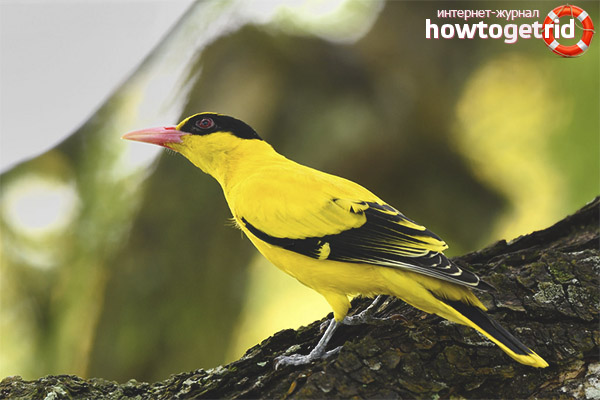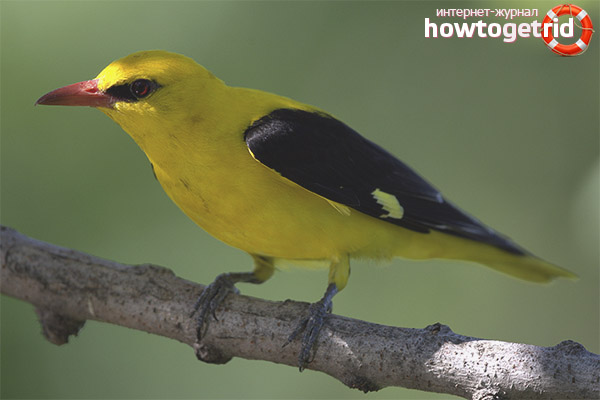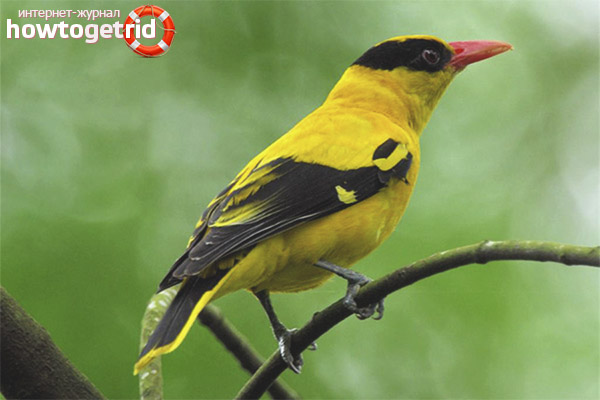The content of the article
The Oriole is a small bird with a small saturated color. In the scientific community, the bird is called Oriolus. In translation, the root of the word sounds like "golden." It must be assumed that such a name for the bird was due to its bright saturated color.
Oriole is a songbird. By its nature, singing resembles playing the flute. Such singing is especially relevant for the male during the mating season. It is in this way that he tries to charm and lure the female. Sometimes it can sing so that the song resembles the meowing of feline representatives of the animal kingdom, familiar to all. But such a timbre coloring of a voice is not always characteristic of a bird, but only at that moment when a clear danger is approaching.
According to the scientific classifier, the detachment into which the bird leads is called the Passeriformes, and the family - the Orioles.
What does it look like?
The bird usually does not exceed 25 cm in length, but the wingspan is naturally much more significant and amounts to 45 cm. A small body weight is also characteristic of a miniature bird. It is only 100 g. Average weight and even less. The feathers of the male have a bright golden color. In the female, the neck area is colored yellow-green. The same color is characteristic of the tail. The color of the beak may be different, but pink or dark brown shades prevail.
The behavior and nature of the diet
The top positions in the rating of poultry feed in the diet are given to insects and fruits. This is due to the fact that the main habitat of the Orioles is trees. Climbing a tree, birds have wide access to various insects. She can easily eat mosquitoes, various bugs, butterflies, their caterpillars.
Of the fruits in the forefront in terms of preference is a pear. But do not mind the bird to taste cherries, apricots, other fruits. For its feeding, the bird mainly chooses the time in the morning. The rest of the time she only does snacks.
Habitat characterization
Bird can be found on the European and Asian continents, in the open spaces of the north-west of the African continent. In our country, it can be seen in the southwest of Siberian territory. The preferred location for the bird are trees that are located near the pond. It can often be found in rare deciduous and pine forests. The bird is well camouflaged in the midst of foliage, so it is extremely difficult to make out. If the Oriole climbs to a tree very high, then it is almost impossible to see it there.
The Oriole is a typical migratory bird. With the onset of August flies away. The final destination of her journey is tropical Africa. He is in no hurry to return and does this only in the second half of May, when the weather is stable and stable.
On European territory, it never winters. This is due to the fact that in these places in winter it is very difficult to find food. Moreover, it does not tolerate comfortably enough the low temperatures existing in these parts.
Species characteristics
Wildlife has more than 24 species of this bird representative. Sometimes the differences between them are small, and sometimes they are more significant.
Oriole
It represents the species most prevalent. The location is Europe, Asia, Western Siberia of the territory of our country.This species is characterized by the brightness of plumage with a predominance of yellow, black and green colors. Usually black coloration is characteristic of wings and beak. But on the abdomen silver-white shades dominate. Body weight does not exceed 90 g, and the length is 25 cm.
This is not to say that this species is food-hungry. The diet consists of fruits and small animals. The bird is well recognized due to the presence of bright colors. Other species are characterized by a more modest color scheme. The species is characterized by the presence of two subspecies. One of them is characterized by the absence of spots behind the eyes. In another subspecies, on the contrary, it is present.
Green-headed Oriole
Its habitat is Kenya and Tanzania. This species is part of the tropical. Likes to be in tropical and subtropical forests with plenty of rain. The bird tends to stay close to the reservoirs for the reason that it loves to swim. Oriole - typical cleanliness. She quite often immerses in water in order to wash herself.
In contrast to the previous view, such orioles are slightly smaller. The body is no more than 24 cm in length, and the limiting mass is 65 g. Green shades dominate in the color palette. The paws are characterized by blue colors, and dark brown shades prevail in the color of the beak.
Oriole striped
The most common habitat for this species is New Guinea and Australia. Likes to be in eucalyptus forests. This species has a less bright color with a predominance of pastel colors. The body can reach a length of 28 cm, and the weight is within 96 g.
Oriole black-headed Chinese
It lives in China and Southeast Asia. In the color palette, yellow, green and white predominate. The length of the body does not exceed 26 cm, and weight - 90 g. Under favorable conditions, the maximum can live up to 15 years. The species is characterized by the presence of a red beak. Increased sociability is not characteristic of this species, so birds prefer to constantly be in shelter.
Nun
This species lives in Ethiopia. Prefers moist rainforests. The color palette is similar to the previous view, but differs by the presence of a black head (hence, in fact, it got its name). The beak is characterized by a brown-red color.
Mask Oriole
The habitat is Africa. Prefers moist tropical forests and dense shrubs. Often it can be found in various thickets.
Oriole
Mostly inhabits the island of Sao Tom, whose location is Africa. She chose this territory for herself not by chance. The island has dense forests, in which the Oriole prefers to be. The name of the species is due to the wide beak. This form is possessed only by representatives of this species. The body length is not higher than 22 cm, and everything rarely exceeds 55 g. This species is characterized by clear sexual differences. The male has a black head, and in females it is characterized by a lighter color.
Conditions for keeping and breeding

Many pay tribute to these birds for their bright color. Those who decide to keep this bird at home should learn a number of rules.
It is impossible to immediately place a bird in a cage immediately after capture. She loves freedom very much. If this rule is neglected, then the bird will live no more than 5 days. It is necessary not to put the bird in a cage, but to tame the chick. Being in a cell, you will never hear from her singing, and the owner will lose the opportunity to hear her "heavenly" voice.
Fact! This feathered representative is distinguished by extreme timidity and caution. She will only enjoy viewing when she is at a considerable distance from the person.
It is extremely difficult to cater to the Oriole. He prefers to eat what he finds himself, and he treats the purchased feed extremely negatively.Hence the conclusion suggests itself that raising the Oriole in captivity is an extremely difficult task. Sometimes it is simply impossible, which again is explained by the desire for freedom. Anyone who has decided to breed the Oriole in captivity should remember that the cage must be large in size for its maintenance. Oriole loves to rush about in corners. Her feathers are soft and in a cramped cage she can simply injure them.
This species is characterized by pronounced monogamism. A couple is formed for life. During the year, the female is able to hatch up to 4 eggs, from which the chicks subsequently hatch. Female eggs hatch for 15 days. Egg incubation is carried out by the female. "Man" only sometimes replaces her for a short while. In the first time after the chicks appear, the parents only do what they feed. In the daily diet, feeding the chicks takes up to 15 hours. 15-17 days after the birth of the chicks are capable of independent flight.
Video: Oriole (Oriolus oriolus)











Submit